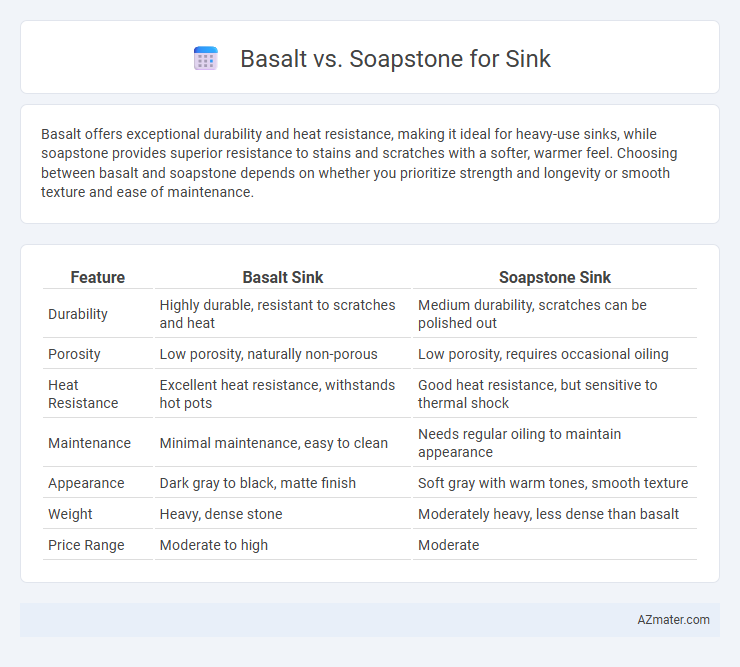Basalt offers exceptional durability and heat resistance, making it ideal for heavy-use sinks, while soapstone provides superior resistance to stains and scratches with a softer, warmer feel. Choosing between basalt and soapstone depends on whether you prioritize strength and longevity or smooth texture and ease of maintenance.
Table of Comparison
| Feature | Basalt Sink | Soapstone Sink |
|---|---|---|
| Durability | Highly durable, resistant to scratches and heat | Medium durability, scratches can be polished out |
| Porosity | Low porosity, naturally non-porous | Low porosity, requires occasional oiling |
| Heat Resistance | Excellent heat resistance, withstands hot pots | Good heat resistance, but sensitive to thermal shock |
| Maintenance | Minimal maintenance, easy to clean | Needs regular oiling to maintain appearance |
| Appearance | Dark gray to black, matte finish | Soft gray with warm tones, smooth texture |
| Weight | Heavy, dense stone | Moderately heavy, less dense than basalt |
| Price Range | Moderate to high | Moderate |
Introduction to Basalt and Soapstone Sinks
Basalt sinks, made from volcanic rock, offer exceptional durability, heat resistance, and a sleek dark appearance ideal for modern kitchens. Soapstone sinks feature a smooth, non-porous surface composed primarily of talc, providing natural antibacterial properties and a warm, matte finish that ages gracefully over time. Both materials present unique benefits in terms of resilience, maintenance, and aesthetic appeal, making them popular choices in sink design and functionality.
Key Physical Properties of Basalt and Soapstone
Basalt is a dense, hard volcanic rock with high compressive strength and excellent resistance to heat and abrasion, making it highly durable for sinks. Soapstone is a softer metamorphic rock composed mainly of talc, known for its heat resistance, non-porous surface, and natural ability to resist stains and bacteria. Both materials offer strong thermal properties, but basalt's toughness contrasts with soapstone's gentle feel and ease of repair.
Aesthetic Differences: Color and Texture
Basalt sinks feature a deep, rich black or dark gray color with a smooth, matte finish that conveys modern elegance and minimalism. Soapstone sinks offer a softer, warmer appearance with shades ranging from light gray to greenish tones, and their slightly textured surface develops a natural patina over time, enhancing rustic charm. The choice between basalt and soapstone hinges on desired aesthetic: basalt's sleek, uniform look contrasts with soapstone's unique, organic texture and subtle color variations.
Durability and Hardness Comparison
Basalt sinks offer exceptional durability due to their dense, fine-grained volcanic rock composition, which provides high resistance to scratches, chips, and heat. Soapstone, while softer and more susceptible to surface scratches, is highly resistant to acids and stains, making it a practical choice for kitchen sinks requiring chemical durability. The hardness of basalt typically rates around 6-7 on the Mohs scale, surpassing soapstone's 1-2, reflecting basalt's superior toughness for long-lasting sink applications.
Resistance to Stains and Chemicals
Basalt sinks offer exceptional resistance to stains and chemicals due to their dense, non-porous composition, making them ideal for environments exposed to harsh substances. Soapstone sinks, while naturally resistant to many acids and chemicals, are slightly more porous and may require periodic sealing to maintain stain resistance over time. Choosing basalt ensures minimal maintenance and superior durability against discoloration, whereas soapstone provides a softer aesthetic with moderate resistance that demands regular care.
Maintenance and Cleaning Requirements
Basalt sinks require minimal maintenance with routine cleaning using mild soap and water to prevent surface degradation, while avoiding acidic or abrasive cleaners that can damage the stone's finish. Soapstone sinks are highly resistant to stains and scratches, allowing for easy upkeep through regular wiping and periodic oiling to preserve their smooth, matte appearance. Both materials benefit from gentle cleaning approaches to maintain their durability and aesthetic appeal in kitchen or bathroom environments.
Installation Considerations
Basalt sinks require professional installation due to their substantial weight and density, necessitating sturdy cabinetry and proper support to prevent damage over time. Soapstone sinks, being softer and more malleable, allow for easier custom shaping and fitting but still demand careful sealing and maintenance to avoid staining. Both materials benefit from expert handling to ensure durability and a seamless, leak-proof installation in kitchen or bathroom settings.
Cost and Value Analysis
Basalt sinks typically range from $200 to $500, offering high durability and a modern aesthetic that justifies their mid-range price point. Soapstone sinks, priced between $300 and $700, provide superior heat and chemical resistance, enhancing long-term value despite higher initial costs. Evaluating cost versus longevity, basalt offers affordability and style, while soapstone delivers premium durability and timeless appeal, making it a preferred investment for kitchens with heavy use.
Environmental Impact and Sustainability
Basalt sinks offer high durability and are sourced from abundant volcanic rock, resulting in low environmental disruption during extraction and minimal waste generation. Soapstone sinks are composed of natural talc-rich metamorphic rock, prized for their longevity and resistance to chemicals, which reduces the need for frequent replacements and lowers overall environmental impact. Both materials are sustainable choices, but soapstone's natural non-porosity and ease of maintenance can enhance its eco-friendly profile by minimizing water and cleaning product consumption over time.
Best Applications: Choosing the Right Stone Sink
Basalt sinks excel in durability and resistance to heat and scratches, making them ideal for high-traffic kitchen environments where longevity is essential. Soapstone, valued for its chemical resistance and smooth texture, is perfect for laboratory sinks or kitchens requiring a surface that resists acidic substances and stains. Selecting between basalt and soapstone depends on whether the application prioritizes toughness and thermal stability or chemical inertness and a softer, tactile finish.

Infographic: Basalt vs Soapstone for Sink
 azmater.com
azmater.com